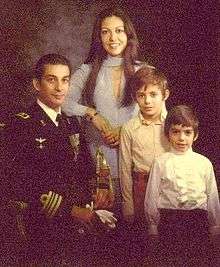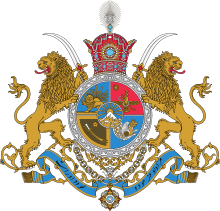Shahriar Shafiq
| Shahriar Shafiq | |
|---|---|
 | |
| Born |
15 March 1945 Cairo, Egypt |
| Died |
7 December 1979 (aged 34) Paris, France |
| Spouse | Maryam Eghbal |
| Issue | Nader and Dara Shafiq |
| House | Pahlavi dynasty |
| Father | Ahmad Shafiq |
| Mother | Ashraf Pahlavi |
Shahriar Shafiq (Persian: والاگهر شهریار شفیق ; 15 March 1945, Cairo, Egypt – 7 December 1979, Paris, France) was the son of Princess Ashraf Pahlavi, twin sister of the Shah of Iran, and Ahmad Shafiq.
Early life and education
Shafiq was born in Cairo on 15 March 1945.[1][2] He was the son of Ashraf Pahlavi and Ahmad Shafiq, and brother of Azadeh Shafiq.[1]
Shafiq was educated at the Royal Navy College in Dartmouth, the United Kingdom.[3]
Personal life
In 1967, Shafiq married Maryam Eghbal, the Christian daughter of Manouchehr Eghbal, who had married at age 18 to Mahmoud Reza Pahlavi in October 1964, one of his uncles and a half-brother of the Shah.[1][4] Shafiq and Eghbal had two sons:[1]
- H.H. Prince Nader Shafiq (born 15 March 1968)
- H.H. Prince Dara Shafiq (born 1970)
| Styles of Prince Shahriar Shafiq | |
|---|---|
 | |
| Reference style | His Highness |
| Spoken style | Your Highness |
| Alternative style | Sir |
Career and activities
Shafiq was an Imperial Iranian Navy Captain.[5] He and his cousin Prince Kamyar Pahlavi, son of Abdul Reza Pahlavi, were the only members of the Pahlavi Dynasty who chose military careers. In addition, Shafiq was the only highest-ranking military officer in the Pahlavi family.[6] He worked in the navy of Iran from 1963 to 1979.[7] He served as the commander of the Persian Gulf fleet of Hovercraft before the 1979 revolution.[8]
Shafiq served also as the head of judo and karate federation during the reign of Muhammad Reza.[9]
Later years and assassination
After the revolution of February 1979, he was the only member of the Pahlavi dynasty to stay in Iran and keep fighting against the revolutionaries, up to the point when he had to flee in a small boat from the Persian Gulf to Kuwait, under heavy fire.[8] He fled Iran in March 1979.[5]
After leaving Iran, Shafiq first went to the United States.[6] Then he joined his family in Paris, France, on 14 November 1979,[6] and began organizing a resistance movement against the Islamic Republic.[10] He founded the group, Iran Azad (Free Iran), which was later led by his sister Azadeh with whom he was living in Paris.[11][12] They both acted as the Pahlavi family’s principal spokesmen.[13] In Iran, Islamic judge Ayatollah Sadeq Khalkhali tried and sentenced him and other members of the Pahlavi family in absentia to death in a secret trial in the spring of 1979.[6][10]
He was assassinated in Paris on 7 December 1979, being shot twice in the head by the agents of the Islamic Republic on the Rue Pergolese,[5][14] outside his mother's home.[15] He was aged 34.[12] The attack was carried out by a masked gunman.[6] Ayatollah Khalkhali claimed that the assassination was carried out by one of his death squads[6] and therefore, Shafiq was the first victim of the Iran's death squads.[16] The Muslim Liberation Group announced that it was responsible for the assassination.[17]
Shahriar's body was not buried, but embalmed and moved to New York where it has been kept by his mother.[18]
References
- 1 2 3 4 "The Pahlavi Dynasty". Iran. Retrieved 4 November 2012.
- ↑ Ulbrich, Jeffrey (10 December 1979). "Killer of Shah's Nephew Hunted". The Virgin Islands Daily News. Paris. AP. Retrieved 5 November 2012.
- ↑ Kadivar, Cyrus (31 October 2003). "Villa Dupont". Iranian. Retrieved 4 August 2013.
- ↑ "People Make News". The Calgary Herald. 22 October 1964. Retrieved 9 November 2012.
- 1 2 3 "Mr. Shahriar Shafiq". OMID. Retrieved 4 November 2012.
- 1 2 3 4 5 6 "Shah's nephew assassinated by 'death squad'". Middlesboro Daily News. Paris. UPI. 8 December 1979. Retrieved 4 November 2012.
- ↑ "Shah says his nephew was gallant naval officer". Toledo Blade. New York. Reuters. 7 December 1979. Retrieved 5 November 2012.
- 1 2 Kadivar, Cyrus (December 2002 – January 2003). "Dialogue of Murder". Rouzegar (8). Retrieved 4 November 2012.
- ↑ "Pictures". Sapia. Retrieved 7 November 2012.
- 1 2 "Secret police blamed for slaying". The Telegraph Daily. Paris. UPI. 9 December 1979. Retrieved 4 November 2012.
- ↑ Anoushiravan Ehteshami (1995). After Khomeini: The Iranian Second Republic. New York: Routledge. Retrieved 12 September 2013. – via Questia (subscription required)
- 1 2 Franklin L. Ford (1985). Political Murder: From Tyrannicide to Terrorism. Harvard University Press. p. 334. ISBN 978-0-674-68636-6. Retrieved 4 August 2013.
- ↑ "No Safe Haven: Iran's Global Assassination Campaign". Iran Human Rights. 2008. Retrieved 4 August 2013.
- ↑ "Bakhtiar escapes assassination attempt". Daily News. 17 July 1980. Retrieved 4 November 2012.
- ↑ Lesh, Carolyn (8 December 1979). "Shah's kin slain". The Bryan Times. Paris. UPI. Retrieved 4 November 2012.
- ↑ John Thompson; Sara Akrami (1 February 2012). "The Mullahs' History of Assassination". Front Page Magazine. Retrieved 5 August 2013.
- ↑ Rizvi, Sajid (8 December 1979). "Iranian situation is very unclear". The Bryan Times. Tehran. UPI. Retrieved 4 November 2012.
- ↑ Chambers, Andrea (5 May 1980). "In Bitter American Exile, the Shah's Twin Sister, Ashraf, Defends Their Dynasty". People. 13 (18). Retrieved 8 August 2013.